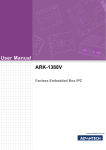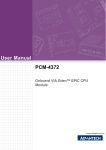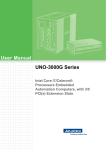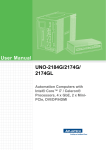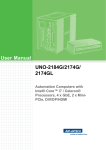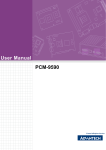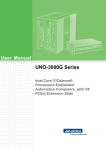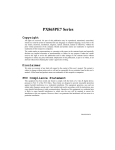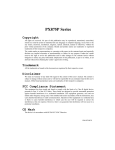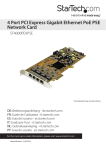Download User Manual ARK-1382
Transcript
User Manual ARK-1382 Ultra Compact Embedded System Copyright The documentation and the software included with this product are copyrighted 2008 by Advantech Co., Ltd. All rights are reserved. Advantech Co., Ltd. reserves the right to make improvements in the products described in this manual at any time without notice. No part of this manual may be reproduced, copied, translated or transmitted in any form or by any means without the prior written permission of Advantech Co., Ltd. Information provided in this manual is intended to be accurate and reliable. However, Advantech Co., Ltd. assumes no responsibility for its use, nor for any infringements of the rights of third parties, which may result from its use. Acknowledgements Intel and Pentium are trademarks of Intel Corporation. Microsoft Windows and MS-DOS are registered trademarks of Microsoft Corp. All other product names or trademarks are properties of their respective owners. Product Warranty (2 years) Advantech warrants to you, the original purchaser, that each of its products will be free from defects in materials and workmanship for two years from the date of purchase. This warranty does not apply to any products which have been repaired or altered by persons other than repair personnel authorized by Advantech, or which have been subject to misuse, abuse, accident or improper installation. Advantech assumes no liability under the terms of this warranty as a consequence of such events. Because of Advantech’s high quality-control standards and rigorous testing, most of our customers never need to use our repair service. If an Advantech product is defective, it will be repaired or replaced at no charge during the warranty period. For outof-warranty repairs, you will be billed according to the cost of replacement materials, service time and freight. Please consult your dealer for more details. If you think you have a defective product, follow these steps: 1. Collect all the information about the problem encountered. (For example, CPU speed, Advantech products used, other hardware and software used, etc.) Note anything abnormal and list any onscreen messages you get when the problem occurs. 2. Call your dealer and describe the problem. Please have your manual, product, and any helpful information readily available. 3. If your product is diagnosed as defective, obtain an RMA (return merchandise authorization) number from your dealer. This allows us to process your return more quickly. 4. Carefully pack the defective product, a fully-completed Repair and Replacement Order Card and a photocopy proof of purchase date (such as your sales receipt) in a shippable container. A product returned without proof of the purchase date is not eligible for warranty service. 5. Write the RMA number visibly on the outside of the package and ship it prepaid to your dealer. Part No. 2006138201 Edition 2 November 2008 ARK-1382 User Manual ii Technical Support and Assistance 1. 2. Visit the Advantech web site at www.advantech.com/support where you can find the latest information about the product. Contact your distributor, sales representative, or Advantech's customer service center for technical support if you need additional assistance. Please have the following information ready before you call: – Product name and serial number – Description of your peripheral attachments – Description of your software (operating system, version, application software, etc.) – A complete description of the problem – The exact wording of any error messages Warnings, Cautions, and Notes Caution! There is a danger of a new battery exploding if it is incorrectly installed. Do not attempt to recharge, force open, or heat the battery. Replace the battery only with the same or equivalent type recommended by the manufacturer. Discard used batteries according to the manufacturer’s instructions. Packing List Before installation, please ensure the following items have been shipped: ! Item Part Number – 1 ARK-1382 unit – 1 Utility CD – 1 Registration and 1 year Warranty card Rev. A – 1 2-Pole Phoenix to DC-Jack Power Cable 1700001394 – 1 DVI-I to VGA connector – 1 WLAN antenna (ARK-1382W version) Ordering information Model Number Description ! ! ! ARK-1382-S0A1E Intel ULV Celeron® M 423 1.06GHz, 2 x Serial ports,1 x Giga LAN, 5 x USB 2.0, 2 x DVI-I,Ultra Compact, Fanless Embedded Box Computer ARK-1382W-S0A1E Intel Celeron ULV423 1.06, 2 x serial ports, 1 x Giga LAN, 5 x USB 2.0, 2 x DVII, XPe, 512MB DDR2 memory, 1GB CF card, Ultra Compact, Fanless Embedded Box Computer ARK-1382-S2A1E Intel CoreTM Duo ULV U2500 1.2GHz,2 x Serial ports, 1 x Giga LAN, 5 x USB 2.0, 2 x DVI-I, Ultra Compact, Fanless Embedded BOX Computer iii ARK-1382 User Manual Optional accessories 1757000222 AC-to-DC Adapter DC19 V/3.42 A 65 W, with Phoenix Power Plug, 0 ~ 40° C for Home and Office Use 1750003222 802.11b/g 5dBi Dipole Antenna 1700001947 Power Cable 2-pin 180 cm, USA type 1700001948 Power Cable 2-pin 180 cm, Europe Type 1700001949 Power Cable 2-pin 180 cm, UK Type 9666K10000E DIN-Rail mounting kit for ARK-1000 series models 9666K10001E VESA mounting kit for ARK-1000 series models 1700004713 Cable DVI to DVI and CRT 15cm ARK-1382 User Manual iv Contents Chapter 1 General Introduction ...........................1 1.1 1.2 Introduction ............................................................................................... 2 Product Feature ........................................................................................ 3 1.2.1 General ......................................................................................... 3 1.2.2 Display .......................................................................................... 3 Chipset ...................................................................................................... 4 1.3.1 Functional Specification ................................................................ 4 1.3.2 Mechanical Specifications............................................................. 8 Figure 1.1 ARK-1382 Dimensions ............................................... 8 1.3.3 Electrical Specifications ................................................................ 9 1.3.4 Environmental Specifications........................................................ 9 1.3 Chapter 2 H/W Installation..................................11 2.1 Jumpers .................................................................................................. 12 2.1.1 Jumper Description ..................................................................... 12 2.1.2 Jumper Setting............................................................................ 13 2.1.3 Locating Jumpers on the Board .................................................. 15 Connectors.............................................................................................. 16 Figure 2.1 ARK-1382 Front Side External I/O Connectors ........ 16 Figure 2.2 ARK-1382 Rear Side External I/O Connectors......... 16 2.2.1 ARK-1382 Front Side External I/O Connectors .......................... 17 Figure 2.3 COM Connector........................................................ 17 Table 2.1: COM Standard Serial Port Pin Assignments ............ 17 Figure 2.4 USB Connector......................................................... 17 Table 2.2: USB Connector......................................................... 17 Figure 2.5 Ethernet Connector .................................................. 18 Table 2.3: RJ-45 Connector Pin Assignments........................... 18 2.2.2 ARK-1382 Rear Side External I/O Connectors ........................... 19 Figure 2.6 DVI-I Connector........................................................ 19 Table 2.4: DVI-I Connector Pin Assignment.............................. 19 Figure 2.7 eSATA/USB Connector ............................................ 20 Table 2.5: eSATA/USB Connector Pin Assignment .................. 20 Figure 2.8 Power Input Connector............................................. 20 Table 2.6: Power Connector Pin Assignments .......................... 20 2.2 Chapter 3 BIOS Operation ..................................21 3.1 3.2 BIOS Introduction.................................................................................... 22 BIOS Setup ............................................................................................. 22 3.2.1 Main Menu .................................................................................. 23 3.2.2 Standard CMOS Features .......................................................... 24 3.2.3 Advanced BIOS Features ........................................................... 25 3.2.4 Advanced Chipset Features........................................................ 27 3.2.5 Integrated Peripherals................................................................. 28 3.2.6 Power Management Setup ......................................................... 29 3.2.7 PnP/PCI Configurations .............................................................. 31 3.2.8 PC Health Status ........................................................................ 31 3.2.9 Frequency/Voltage Control ......................................................... 32 3.2.10 Load Optimized Defaults............................................................. 32 3.2.11 Set Password.............................................................................. 33 3.2.12 Save & Exit Setup ....................................................................... 34 3.2.13 Exit Without Saving..................................................................... 34 v ARK-1382 User Manual Chapter 4 Full Disassembly Procedure............ 35 4.1 Introduction ............................................................................................. 36 Appendix A Realtek RTL8111B/8111C Gigabit Boot Agent Configuration Menu...... 43 A.1 Realtek RTL8111B/8111C Gigabit Boot Agent Configuration Menu ...... 44 ARK-1382 User Manual vi Chapter 1 1 General Introduction 1.1 Introduction ARK-1382 is a fanless, ultra-compact system designed for a wide range of applications such as Point Of Information systems, flight information display systems, and vehicle video player system. ARK-1382 is designed with Intel® ULV Celeron® M 423 1.06GHz/ CoreTM Duo ULV U2500 1.2GHz Processor, which provides excellent computing and multimedia performance. The system is equipped with 802.11b/g WLAN card and supports a wide range of input voltages from 9 VDC to 35VDC. Moreover, to fit different applications, ARK-1382 supports dual DVI-I independent display or dual VGA with clone mode. Despite the smallest size, ARK-1382 still supports 5 x USB 2.0, 1 x Giga LAN and 2 x COM ports, user can easily install the CF card via external CF socket. The ARK-1382 Compact Embedded Computer is equipped with a solid state onboard CF card of up to 8 GB, so it easily passes 50 and 5 Grms shock and vibration tests. ARK-1000 can be standalone, wall-mounted, DIN-rail mounted or VESA mounted. The series accepts a wide range of power supplies (DC power in) and comes in a footprint of only 189 x 41 x 130.6 mm (7.44" x 1.61" x 5.14"). The rugged cast aluminum case not only provides great protection from EMI, shock/vibration, cold and heat, but also passive cooling for super quiet, fanless operation. ARK-1382 User Manual 2 1.2.1 General 1.2.2 Display ! ! ! ! ! Chipset: Intel 945GM integrated 2D/3D graphic controller Memory Size: Supports Intel DVMT (Dynamic Video Memory Technology) 3.0 1 MB or 8 MB under system BIOS Resolution: CRT Display mode: pixel resolution up to 1600 x 1200 at 85-Hz and 1600 x 1200 at 75-Hz LCD Display mode: Display Interface: 2 x DVI-I, (VGA interface can be extended by connector) Dual Independent: DVI + DVI; DVI + VGA; (VGA +VGA only supports clone mode) 3 ARK-1382 User Manual General Introduction CPU Intel® ULV Celeron® M 423 1.06GHz/ CoreTM Duo ULV U2500 1.2GHz ! System Chipset: 945GM chipset 533 MHz FSB ! BIOS: AWARD® 4 Mbit Flash BIOS ! System Memory: 200-pin SODIMM socket, Supports ECC Double Data Rate (DDR2) 128 MB to 1 GB, DDR2 400/533 MHz ! Power Management: APM1.2, ACPI 2.0 support ! SSD: Supports CompactFlash® Card TYPE I/II (shared 1st IDE Channel) USB memory ! Watchdog Timer: Single chip Watchdog 255-level interval timer, setup by software ! Expansion Interface: 1 x miniPCI (Equipped with miniPCI WLAN card for ARK1382W version) ! Battery: 3V/210 mAh ! I/O Interface: 2 x RS232/422/485 (default is RS-232, RS-422/485 by jumper setting) ! USB: 5 x USB 2.0 compliant Ports, one combined with eSATA ! Audio: ALC203 AC97 surround stereo sound and dual output 2.2 W amplifier. Supports Line-out (Left and Right) ! IrDA: N/A ! GPIO: N/A ! LAN Chipset: Realtek 8111B PCI-E 10/100/1000 Base-T ! Speed: 10/100/1000 Mbps ! Interface: 1 x RJ45 ! Standard: IEEE 802.3u 100Base-T Chapter 1 1.2 Product Feature 1.3 Chipset 1.3.1 Functional Specification 1.3.1.1 Processor CPU: Processor ! ! Supports 533 MHz Source-Synchronous Processor System Bus Supports Intel Celeron ULV423 at 1.06 GHZ CPU ! Supports Intel® CoreTM Duo ULV U2500 1.2GHz Processor (ARK1382-S2A1E) Package: 35 mm x 35 mm Micro-FCBGA ! 1.3.1.2 Chipset NB: Intel 945GM GMCH chip supports: Memory ! ! ! Supports 400/533 MHz DDR2 SDRAM devices with max Supports maximum 1GB DDR SDRAM. SO-DIMM Socket on board: 200 pin SO-DIMM socket type x 1 Note: There may be compatibility issues with support for 2 GB memory; please check with the Advantech support team. NB: Intel 945GM GMCH chip supports: ! ! Graphic and Video Controllers ! ! ARK-1382 User Manual Internal Graphics Features Dual display choose on board: Dual DVI, Dual VGA or DVI + VGA through OS Driver – DVI-I (CRT) Integrated 400-MHz, Three 8-bit DACs provide the R, G, and B signals to the monitor Supports pixel resolution up to QXGA Supports Display Hot Plug Supports Dual VGA Display via Video Separate Amplifier – DVI-I (DVI) Supports DVI 1.0 for External Digital Monitor Supports Display Hot Plug DVI Transmitter Support Digital Visual Interface (DVI) Transmitter up to 165M pixels/second Supports Dual DVI Display Independently WinXP Extended desktop support for Dual DVI and DVI + VGA DVI-I Connector on board: DVI-I Combined Conn. 29P 90D(F) x 2 4 IDE Interface ! ! ! ! ! Supports PIO IDE transfers up to 16 Mbytes/sec Supports Ultra ATA transfers to 100/66/33 Mbytes/sec The IDE interface integrates 16x32-bit buffers for optimal transfers Supports Compact Flash Card Type II Socket CF Socket on board: CF Type II 50P 90D(M) external connector x 1 Chapter 1 SB: Intel NH82801GHM chip supports: SB: Intel NH82801GHM chip supports: ! ! ! ! ! Supports Audio Codec’97, Revision 2.3 specification Supports Link for Audio and Telephony CODECS Supports Dual 2.2W Audio Amplifier Plus Stereo RCA Jack on Board: 3P 90D(F) Red x 1 (Right Channel) RCA Jack on Board: 3P 90D(F) White x 1 (Left Channel) SB: Intel NH82801GHM chip supports: ! USB Interface ! ! ! ! USB host interface with support for 5 USB 2.0 ports (1 combined with eSATA) All ports are High-Speed, Full-Speed, and Low-Speed capable Supports legacy keyboard/mouse software USB dual connector on board: USB conn 8P 90D(M) DIP x 2 USB + eSATA connector on board: E-SATA+USB 11P 90D(M) DIP x 1 SB: Intel NH82801GHM chip supports: eSATA Interface ! ! ! Supports the Serial ATA specification Revision 1.0a Supports several optional sections of Serial ATA II: Extensions to Serial ATA 1.0 Specification, Revision 1.0 USB + eSATA connector on board: E-SATA+USB 11P 90D(M) DIP x 1 Note: eSATA does not support PnP function. SB: Intel NH82801GHM chip: Mini PCI Interface ! ! ! ! Supports Mini PCI Interface 1.0 Supports Mini PCI WLAN extension card use only Supports 802.11A/B/G when use 9680005627 Mini PCI socket: MINI PCI 124P 180D(F) SMD x 1 (ARK-1382W version, miniPCI is equipped with WLAN miniPCI card) Power Management SB: Intel NH82801GHM chip: ! ! ! Supports ACPI 3.0 ACPI Power Management Logic Support Power connector: Plug-In block 2P DIP x 1 5 ARK-1382 User Manual General Introduction Audio Link SB: Intel NH82801GHM chip: BIOS ! ! ! ! Low Pin Count (LPC) interface support Firmware Hub (FWH) interface support Phoenix 4M bit Flash BIOS, supports Plug & Play, APM 1.2/ACPI 1.1. Socket: 32 pin PLCC socket x 1 1.3.1.3 Others (chipset) Super I/O: Winbond W83627HG: Serial Ports ! ! ! ! ! 2 full function serial ports by Winbond W83627 Supports IRQ Sharing among serial ports on XPE COM1: Supports RS-232/422/485 via jumper setting COM2: Supports RS-232/422/485 via jumper setting COM connector: D-SUB CON. 9P 90D(M)DIP x 2 Note: RS-485 does not support Auto flow control. Please refer to CH2 for jumper settings. Super I/O: Winbond W83627HG supports: Thermal sensor ! ! Monitoring the current CPU temperature Monitoring the main power voltage LAN Chip: Realtek RTL8111B-GR: LAN ! ! ! ! ! Supports PCI Express 1.0a Integrated 10/100/1000 transceiver Fully compliant with IEEE 802.3 compliant Supports Wake on LAN and remote wake-up Giga LAN RJ45 connector on board Audio Codec: Realtek ALC203 Amplifier: National LM4863 Audio ! ! ! ! ! ARK-1382 User Manual Compliant with AC97 2.3 specifications Supports to 20-bit DAC and 18-bit ADC resolution Supports Dual 2.2W Audio Amplifier Plus Stereo RCA Jack on board: 3P 90D(F) red x 1 (Right Channel) RCA Jack on board: 3P 90D(F) white x 1 (Left Channel) 6 ! ! DVI ! ! ! Digital Visual Interface (DVI) Transmitter up to 165M pixels/second High-speed SDVO (1G~2Gbps) AC-coupled serial differential RGB inputs Complete Windows and DOS driver support DVI hot plug detection DVI-I Connector on board: DVI-I Combined Conn. 29P 90D(F) x 2 VGA ! ! Supports Dual VGA Display via Video Separate Amplifier Share with DVI-I Connector on board: DVI-I Combined Conn. 29P 90D(F) x 2 Battery support: CR2032 Battery backup ! BATTERY 3V/210 mAh with WIRE x 1 Wireless LAN Module Card: WM3210 WLAN (Optional) ! ! ! Supports Mini PCI Interface 1.0 Supports 802.11 b/g Mini PCI socket: MINI PCI 124P 180D(F) SMD x 1 7 ARK-1382 User Manual General Introduction Video Amplifier: Linear LT6557 x 2 Chapter 1 DVI Transmitter: Chrontel CH7307C x 2 1.3.2 Mechanical Specifications 130,6 78,8 145,4 1.3.2.1 Dimensions (mm) 189 x 41 x 130.6mm (7.44” x 1.61” x 5.14”) Detail A 165,0 5.1 14.4 8,0 41,0 3,6 3,8 189,0 Figure 1.1 ARK-1382 Dimensions 1.3.2.2 Weight (kg) 1.15 kg ARK-1382 User Manual 8 Detail A 1.3.3.1 Power Supply Voltage Voltage requirement with Adaptor: 9 V-3.8 A ~ 35 V-1 A Adaptor 1.3.3.2 Power Supply Current Supply Current (Maximum) CPU: Intel Celeron ULV423 1.06, RAM:533MHz 512GB DDR2 SDRAM 19 V DOS 0.86 A BIOS NC WINXP Idle 0.88 A WINXP HCT11.0 NC WINXP 3DMARK2001SE NC WINXP BURN IN TEST 1.16 A Suspend 0.66 A General Introduction Adaptor Chapter 1 1.3.3 Electrical Specifications 1.3.3.3 RTC Battery Nominal Voltage: 3.0 V Nominal discharge capacity: 210 mAh 1.3.4 Environmental Specifications 1.3.4.1 Operating Temperature The Intel® Celeron® is specified for proper operation when the junction temperature is within the specified range of 0° C to 100° C. The Intel® 945GM chipset temperature runs at a maximum of 100° C. The Intel® ICH7 I/O Controller Hub 7 (82801GHM) case temperature runs at a maximum of 110° C. The processor protects itself from catastrophic overheating by use of an internal thermal sensor at a temperature level of approximately 135° C. Intel® ULV Celeron® M 423 1.06GHz: 0~60C (32~140F) with airflow condition Intel® CoreTM Duo ULV U2500 1.2GHz Processor: 0~50C (32~122F) with airflow condition * Reference airflow condition: 0.7 meter/sec 1.3.4.2 Operating Humidity 0% ~ 90% relative humidity, non-condensing 1.3.4.3 Storage Temperature -20 ~ 70° C 1.3.4.4 Storage Humidity Up to 95% @ 60° C 9 ARK-1382 User Manual ARK-1382 User Manual 10 Chapter 2 H/W Installation 2 2.1 Jumpers 2.1.1 Jumper Description Cards can be configured by setting jumpers. A jumper is a metal bridge used to close an electric circuit. It consists of two metal pins and a small metal clip (often protected by a plastic cover) that slides over the pins to connect them. To close a jumper, you connect the pins with the clip. To open a jumper, you remove the clip. Sometimes a jumper will have three pins, labeled 1, 2 and 3. In this case you would connect either pins 1 and 2, or 2 and 3. The jumper settings are schematically depicted in this manual as follows. 1 2 3 A pair of needle-nosed pliers may be helpful when working with jumpers. If you have any doubts about the best hardware configuration for your application, contact your local distributor or sales representative before you make any changes. Warning! To avoid damaging the computer, always turn off the power supply before setting jumpers. Clear CMOS. Before turning on the power supply, set the jumper back to 3.0 V Battery On. ARK-1382 User Manual 12 2.1.2.1 COM1 Jumper ARK-1382 series uses jumpers - JP1 ~ JP3 located on the internal carrier board for COM1 selecting the RS-232, RS422 and RS485. JP1 Function 1-3 RS-232* 2-4 RS-232* 3-5 RS-422/RS-485 4-6 RS422/RS-485 H/W Installation Close pins (*): means default setting of the jumper/function. JP2 Close pins Function 1-3 RS-232* 2-4 RS-232* 3-5 RS-422/RS-485 4-6 RS-422/RS-485 (*): means default setting of the jumper/function. JP3 Close pins Function 1-2 RS-485 3-4 RS-422 5-6 RS-232* (*): means default setting of the jumper/function. 13 Chapter 2 2.1.2 Jumper Setting ARK-1382 User Manual 2.1.2.2 COM2 Jumper ARK-1382 uses jumpers - JP4 ~ JP6 located on the internal carrier board for COM2 selecting RS-232, RS422 and RS485.] JP4 Close pins Function 1-3 RS-232* 2-4 RS-232* 3-5 RS-422/RS-485 4-6 RS422/RS-485 (*): means default setting of the jumper/function. JP5 Close pins Function 1-3 RS-232* 2-4 RS-232* 3-5 RS-422/RS-485 4-6 RS-422/RS-485 (*): means default setting of the jumper/function. JP6 Close pins Function 1-2 RS-485 3-4 RS-422 5-6 RS-232* (*): means default setting of the jumper/function. 2.1.2.3 CMOS Jumper (JP8) ARK-1382 uses jumper JP8 located on the internal carrier board for selecting the CMOS for Clear or Normal status. Close pins Function 1-2 Clear CMOS 2-3 Normal* (*): means default setting of the jumper/function. ARK-1382 User Manual 14 Chapter 2 2.1.3 Locating Jumpers on the Board H/W Installation 15 ARK-1382 User Manual 2.2 Connectors Compact Flash Normal LED HDD LED PWR LED Alarm LED USB4 USB2 LAN USB3 USB1 COM1 COM2 ON/OFF Figure 2.1 ARK-1382 Front Side External I/O Connectors VCC GN D Figure 2.2 ARK-1382 Rear Side External I/O Connectors ARK-1382 User Manual 16 2.2.1.1 COM Connector ARK-1382 provides two D-sub 9-pin connectors, which offers RS-232/422/485 serial communication interface ports. Default setting is RS-232, if you want to use RS-422/ 485, you can find the jumper installation in Appendix and jumper setting in 2.12. 1 2 3 4 5 Figure 2.3 COM Connector Table 2.1: COM Standard Serial Port Pin Assignments RS-232 RS-422 RS-485 Pin Signal Name Signal Name Signal Name 1 DCD Tx- DATA- 2 RxD Tx+ DATA+ 3 TxD Rx+ NC 4 DTR Rx- NC 5 GND GND GND 6 DSR NC NC 7 RTS NC NC 8 CTS NC NC 9 RI NC NC Note: NC represents “No Connection”. 2.2.1.2 USB Connector ARK-1382 provides four USB connectors, which provide complete Plug & Play and hot swapping for up to 127 external devices. The USB interfaces are USB UHCI, Rev. 2.0 compliant. The USB interface can be disabled in the system BIOS setup. Please refer to Table. 2.2 for pin assignments. Figure 2.4 USB Connector Table 2.2: USB Connector Pin Signal name Pin 1 VCC 2 USB_data- 3 USB_data+ 4 GND 17 Signal name ARK-1382 User Manual H/W Installation 6 7 8 9 Chapter 2 2.2.1 ARK-1382 Front Side External I/O Connectors 2.2.1.3 Ethernet Connector (LAN) ARK-1382 is equipped with a Realtek RTL8111B-GR Ethernet controller that is fully compliant with IEEE 802.3u 10/100/1000Base-T CSMA/CD standards. The Ethernet port provides a standard RJ-45 jack connector with LED indicators on the front side to show its Active/Link status (Green LED) and Speed status (Yellow LED). Figure 2.5 Ethernet Connector Table 2.3: RJ-45 Connector Pin Assignments Pin 10/100/1000BaseT Signal Name 1 TX+ 2 TX- 3 RX+ 4 NC 5 NC 6 RX- 7 NC 8 NC 2.2.1.4 Compact Flash Card ARK-1382 is equipped with an external CF card. 2.2.1.5 Power ON/OFF Button ARK-1382 comes with a Power On/Off button, that supports the dual functions of Soft Power -On/Off (Instant off or 4 sec. delay), and Suspend. 2.2.1.6 LED Indicators There are four LEDs on ARK-1382 front metal face plate for indicating system status: PWR LED is for power status and flashes green in color; HDD LED is for CompactFlash disk status, which flashes red in color; Normal LED detects if the internal temperature is under 90° C which flashes blue in color, but when the internal temperature is over 90° C, the Normal blue LED will not flash and the orange alarm LED will flash, which means the user must enhance the air flow to dissipate heat. ARK-1382 User Manual 18 2.2.2.1 DVI-I Connector ARK-1382 provides dual DVI-I interface for dual independent display. For VGA monitor, you can use the DVI-I to VGA connector (see packing list P/N: 1654000446), supporting dual independent display for DVI + VGA. Please order the DVI-I to VGA connector separately (P/N: 1654000446). Supports CRT mode: 1600 x 1200 @ 32 bpp @ 85 Hz and up to 32 MB shared memory. Table 2.4: DVI-I Connector Pin Assignment Pin Signal Name Pin Signal name 1 TMDS-C2# 16 HP_DET 2 TMDS-C2 17 TMDS_C0# 3 GND 18 TMDS_C0 4 CRT_DDC_CLK 19 GND 5 CRT_DDC_DATA 20 - 6 MDVI_CLK 21 - 7 MDVI_DATA 22 GND 8 VGAVSY 23 TMDS_CK# 9 TMDS_C1# 24 TMDS_CK 10 TMDS_C1 C1 VGAR 11 GND C2 VGAG 12 - C3 VGAB 13 - C4 VGAHSY 14 VCC_DVI C5 GND 15 GND 2.2.2.2 Line out ARK-1382 supports left- and right-channel line outs. 19 ARK-1382 User Manual H/W Installation Figure 2.6 DVI-I Connector Chapter 2 2.2.2 ARK-1382 Rear Side External I/O Connectors 2.2.2.3 USB5/eSATA ARK-1382 provides an external SATA connector for external storage; if you do not need to use eSATA, the connector can be used as a USB port. 4 5 3 6 7 2 8 1 9 10 11 Figure 2.7 eSATA/USB Connector Table 2.5: eSATA/USB Connector Pin Assignment Pin Signal name 1 VBUS 2 D- 3 D+ 4 GND 5 GND 6 SATA_TX+ 7 SATA_TX- 8 GND 9 SATA_RX- 10 SATA_RX+ 11 GND 2.2.2.4 Power Input Connector ARK-1382 comes with a two-pin header that carries 9 ~ 35 VDC external power input. Figure 2.8 Power Input Connector Table 2.6: Power Connector Pin Assignments Pin Signal Name 1 GND 2 +9 ~ 35 VDC ARK-1382 User Manual 20 Chapter 3 BIOS Operation Sections include: ! BIOS Introduction ! BIOS Setup 3 3.1 BIOS Introduction Advantech provides a full-featured AwardBIOS 6.0 which delivers the superior performance, compatibility, and functionality that manufacturers of Industrial PC and Embedded boards demand; its many options and extensions let you customize your products to a wide range of applications and target markets. The modular, adaptable AwardBIOS 6.0 supports the broadest range of processors, third-party peripherals and popular chipsets including: Intel CPUs from 386 through to Pentium, and AMD Geode to K7 and K8; as well as nVidia and VIA processors. Advantech also provides utilities to easily select and install features that suit the customers’ own designs. 3.2 BIOS Setup The ARK-1382 series has a built-in AwardBIOS with a CMOS SETUP utility which allows the user to configure their required settings or to activate certain system features. The CMOS SETUP saves the configuration in the CMOS RAM on the motherboard. When the power is turned off, the onboard battery supplies the necessary power to the CMOS RAM for configuration settings to be retained. When the power is turned on, press the <Del> button during the BIOS POST (PowerOn Self Test) boot up stage; this will take you to CMOS SETUP. CONTROL KEYS < ↑ >< ↓ >< ← >< → > Move highlight <Enter> Select Item - View submenu or options <Esc> Main Menu - Quit and do not save changes into CMOS Sub Menu - Exit current page and return to higher menu <Page Up/+> Increase the numeric value or make changes <Page Down/-> Decrease the numeric value or make changes <F1> General help - for Setup Sub Menu <F2> Item Help <F5> Load Previous Values <F7> Load Optimized Defaults <F10> Save all CMOS changes ARK-1382 User Manual 22 During bootup, press <Del> to enter the AwardBIOS CMOS Setup Utility; the Main Menu will appear on the screen. Use arrow keys to highlight items and press <Enter> to accept or enter a sub-menu. ! ! ! ! ! ! ! ! ! ! ! 23 ARK-1382 User Manual BIOS Operation ! Standard CMOS Features This setup page includes all the items in the standard compatible BIOS. Advanced BIOS Features This setup page includes all the Award BIOS enhanced features. Advanced Chipset Features This setup page includes all the chipset configuration features. Integrated Peripherals This setup page includes all onboard peripheral devices. Power Management Setup This setup page includes all the Power Management features. PnP/PCI Configurations This setup page includes PnP OS and PCI device configuration. PC Health Status This page includes CPU overheat protection setting, and reports system temperature, CPU temperature, fan speeds, and system voltages. Frequency/Voltage Control This setup page includes settings for PCI clock signal, spread spectrum, and CPU host/SRC/PCI clock speeds. Load Optimized Defaults This option loads values that are optimized for stable, average performance. Set Password Establish, change, or disable passwords. Save & Exit Setup Save CMOS value settings to CMOS and exit BIOS setup. Exit Without Saving Abandon all CMOS value changes and exit BIOS setup. Chapter 3 3.2.1 Main Menu 3.2.2 Standard CMOS Features ! Date The date format is <Weekday>, <Month>, <Day>, <Year>. – – – – ! ! ! ! From Sun to Sat, determined and displayed by the BIOS only From Jan to Dec From 1 to 31 From 1999 through 2098 Time The time format is in <hours> : <minutes> : <seconds>, based on 24-hour time IDE Channel 0 Master/Slave – IDE HDD Auto-Detection. Press "Enter" for automatic device detection. IDE Channel 1 Master/Slave – IDE HDD Auto-Detection. Press "Enter" for automatic device detection. Video The item determines that VGA display support type. – – – – ! Weekday Month Day Year EGA/VGA CGA 40 CGA 80 MONO Support VGA color mode Support VGA color mode Support VGA color mode Support VGA mono mode Halt on This item determines whether the computer bootup process will stop if an error is detected during power up. – No Errors – All Errors The system boot sequence will not stop for any error. Whenever the BIOS detects a non-fatal error the system will stop. – All, but Keyboard The system boot sequence will not stop for a keyboard error, but it will stop for all other errors. (Default value) – All, but Diskette The system boot sequence will not stop for a disk error, but it will stop for all other errors. – All, but Disk/Key The system boot sequence will not stop for a keyboard or disk error, but it will stop for all other errors. ! ! ! Base Memory The BIOS POST displays the amount of base (or conventional) memory installed in the system. Extended Memory The BIOS POST displays the amount of extended memory (above 1 MB in the CPU's memory address map) installed in the system. Total Memory This item displays the total system memory size. ARK-1382 User Manual 24 ! ! ! ! ! ! ! – – – – ! ! ! First Second Third Other Hard Disk USB Device USB-FDD USB-CDROM LAN Disabled [USB Device] [USB-CDROM] [Hard Disk] [Enabled] Select boot device priority by CF. Select boot device priority by USB Device. Select boot device priority by USB-FDD. Select boot device priority by USB-CDROM. Select boot device priority by LAN. Do not include this device for booting. Boot Up NumLock Status [On] When enabled, the keyboard keypad boots up in number mode. When disabled, the keypad boots up in cursor control mode (arrow mode). Gate A20 Option [Fast] This item enables the user to switch A20 control by port 92 (default), or Normal to use slower keyboard controller. Typematic Rate Setting This item enables users to enable or disable typematic action. When enabled, they can set the two typematic controls items. These fields control the speeds of: – Typematic Rate (Chars/Sec) This item controls the speed at which the system registers auto repeated keystrokes. The eight settings are 6, 8, 10, 12, 15, 20, 24 and 30 characters per second. 25 ARK-1382 User Manual BIOS Operation ! Blank Boot [Disabled] (* Advantech feature enhancement) When enabled, the system displays a blank screen during the BIOS POST stage. POST Beep [Enabled] (* Advantech feature enhancement) When enabled, the system emits beep sounds during the BIOS POST stage. CPU Feature This item allows users to adjust CPU features, CPU ratio, VID. Thermal and special features like XD flag. Hard Disk Boot Priority This item allows users to select the boot sequence for system hard drive devices - HDD, SCSI, RAID. USB Boot Priority This item allows user to select boot sequence for USB device Boot. Virus Warning [Disabled] This item allows users to choose or disable the virus warning feature for IDE Hard Disk boot sector protection. Quick Power On Self Test [Enabled] This field speeds up the Power-On Self Test (POST) routine by skipping the second, third, and forth re-tests. Default setting is enabled. First / Second / Third / Other Boot Device BIOS attempts to load the operating system from the boot devices in the order assigned. Chapter 3 3.2.3 Advanced BIOS Features – Typematic Delay (Msec) This item sets the keypress delay before typematic repetition kicks in. The four delay options are 250, 500, 750 and 1000. Note! ! These typematic settings apply to systems that communicate with the keyboard via BIOS. For Windows systems, typematic settings are controlled by keyboard driver settings in Windows Control Panel. Security Option [Setup] – System – Setup ! ! ! ! ! ! System requires password both for bootup and for access to the Setup page. System requires password only for access to the Setup page, not for bootup. (Default value) APIC Mode [Enabled] This item allows user to enable or disable “Advanced Programmable Interrupt Controller”. APIC is implemented in the motherboard and must be supported by the operating system, and it extends the number of IRQ's available. MPS Version Control for OS [1.4] This item sets the system multiprocessor specification version. OS Select For DRAM > 64 M [Non-OS2] Select OS2 only if the system is running OS/2 with greater than 64 MB of RAM on the system. Full Screen Logo Show [Enabled] Shows full screen logo during POST stage; logo image can be customized. Small Logo (EPA) Show [Disabled] Shows EPA logo during system POST stage. Summary Screen Show [Enabled] Shows system status on summary screen page. ARK-1382 User Manual 26 Note! ! ! ! ! ! ! ! ! ! ! ! DRAM Timing Selectable [By SPD] This item enables users to set optimal timings for items 2 through to 5. The system default setting of “By SPD” ensures the system runs with stable and optimal performance. CAS Latency Time [Auto] This item enables users to set the timing delay in clock cycles before the SDRAM starts a read command after receiving it. DRAM RAS# to CAS# Delay [Auto] This item enables users to set the timing of the transition from RAS (Row Address Strobe) to CAS (Column Address Strobe) as both rows and columns are separately addressed shortly after DRAM is refreshed. DRAM RAS# Precharge [Auto] This item enables users to set the DRAM RAS# precharge timing. System default is set to “Auto” to reference the data from SPD ROM. Precharge delay (tRAS) [Auto] This item allows user to adjust memory precharge time. System Memory Frequency [Auto] This item allows user to adjust memory frequency to improvement performance. SLP_S4# Assertion Width [1 to 2 sec.] This item allows user to adjust SLP_S4# signal.This field indicates the minimum assertion width of the SLP_S4# signal to ensure that the DRAMs have been safely power-cycled. System BIOS Cacheable [Enabled] This item allows the system BIOS to be cached to allow faster execution and better performance. Video BIOS Cacheable [Disabled] This item allows the video BIOS to be cached to allow faster execution and better performance. Memory Hole At 15 M-16 M [Disabled] This item reserves 15 MB-16 MB memory address space to ISA expansion cards that specifically require the setting. Memory from 15 MB-16 MB will be unavailable to the system because only expansion cards can access memory in this area. PEG/Onboard VGA Control [Auto] This item allows the user to select whether onboard graphics processor or the PCI Express card. On-Chip Frame Buffer Size [8 MB] This item allows the user to choose Frame Buffer Size. BIOS default value is set to 8 MB. 27 ARK-1382 User Manual BIOS Operation ! This “Advanced Chipset Features” screen controls the configuration of the board’s chipset; this page depends on the particular chipset installed. It is strongly recommended that only technical users make changes to the default settings. Chapter 3 3.2.4 Advanced Chipset Features ! ! ! DVMT Mode [ DVMT] This item allows the user to adjust Intel's Dynamic Video Memory Technology (DVMT).Bios provide three option to choose (DVMT, FIXED and Both). DVMT/FIXED Memory Size [128MB] This item allows the user to adjust DVMT/FIXED graphics memory size. Boot Display [VBIOS Default] This item allows the user to decide bootup display mode. 3.2.5 Integrated Peripherals Note! ! ! ! This “Integrated Peripherals” screen controls the configuration of the board’s chipset, including controls for: IDE, ATA, SATA, USB, AC97, MC97 and Super IO and sensor devices; this section depends on the particular chipset installed. OnChip IDE Device This item enables users to set the OnChip IDE device status, including enabling IDE devices and setting PIO and DMA access mode, plus some new chipset support for SATA devices (Serial-ATA). – IDE HDD Block Mode [Enabled] This item allows the users to enable for automatic detection of optimal number of block read/writes per sector the drive can support if IDE Hard Driver supports block mode. – IDE DMA transfer access Mode [Enabled] This item allows the user to enable the DMA transfer access. – On-Chip Primary / Secondary PCI IDE [Enabled] This item allows the user to select the PIO or UDMA mode. – SATA Mode [IDE] The item allows the users to support IDE mode. – SATA Port Speed Settings [Disabled] This item allows the users to select SATA port speed. Onboard Device This item enables users to set the Onboard device status, including enabling and disabling USB, AC97, MC97 and LAN devices. Super IO Device This item enables users to set the Super IO device status, including enabling Floppy, COM, LPT, IR and control for GPIO and Power Fail status. – Onboard Serial Port 1 [3F8/IRQ4] This item allows the user to change the COM 1 address and IRQ. BIOS default value suggest to .3F8/IRQ4. – Onboard Serial Port 2 [2F8/IRQ3] This item allows the user to chang13 the COM 2 address and IRQ. BIOS default value suggest to .2F8/IRQ3. – UART Mode Select [Normal] This item allows the selection for the mode of operation of the serial port. – Onboard Parallel Port [378/IRQ7] This item allows the user to change the parallel port address. BIOS default value is set to .378/IRQ7. ARK-1382 User Manual 28 Note! ! ! ! ! ! This “Power Management Setup” screen configures the system to most effectively save energy while still operating in a manner consistent with intended computer use. ACPI Function [Enabled] This item defines the ACPI (Advanced Configuration and Power Interface) feature that makes hardware status information available to the operating system, and communicates PC and system device information for improving power management. ACPI Suspend Type [S1 (POS)] This item allows users to select sleep state when the system is in suspend mode. – S1(POS) Suspend mode is equivalent to a software power down. – S3(STR) The system shuts down with the exception of a refresh current to the system memory. – S1 & S3 This item is support two mode be selection by software. Run VGA BIOS if S3 Resume [Auto] This item allows the system to reinitialize the VGA BIOS after the system has resumed from ACPI S3 mode. Power Management Option [User Define] This item allows user to select system power saving mode. – Min Saving Minimum power management. Suspend Mode=1 hr. – Max Saving Maximum power management. Suspend Mode=1 min. – User Define Allows user to set each mode individually. Suspend Mode= Disabled or 1 min ~1 hr. Video Off Method [DPMS] This item allows users to determine the manner in which the monitor is blanked. – V/H SYNC+Blank This option will cause the system to turn off vertical and horizontal synchronization ports and write blanks to the video buffer. – Blank Screen This option only writes blanks to the video buffer. – DPMS Initial displays power management signaling. 29 ARK-1382 User Manual BIOS Operation 3.2.6 Power Management Setup Chapter 3 ! – Parallel Port Mode [SPP] This item allows the user to change the parallel port mode. The user can choose .SPP., .EPP., .±ECP. and .ECP+EPP.; SPP (Standard Parallel Port ); ECP (Extended Capabilities Port); and EPP (Enhanced Parallel Port). The BIOS default value is set to .Normal.. – EPP Mode Select [EPP1.7] This item allows the user to change the EPP Mode for the parallel port. The BIOS default value is set to .EPP1.7.. – ECP Mode Use DMA [3] This item allows the user to change the DMA channel for the parallel port. The BIOS default value is set to 3. PWRON After PWR-Fail [Off] This item allows user to select system power status after power loss. ! ! ! ! ! ! ! ! ! ! ! Video Off In Suspend [Yes] This item allows users to turn off video when entering suspend mode. Suspend Type [Stop Grant] This item allows users to determine the suspend type. Modem use IRQ [3] This item allows users to determine which IRQ the MODEM can use. Suspend Mode [Disabled] Shows the time of system inactivity before all devices except the CPU will be shut off. HDD Power Down Mode [Disabled] Shows the time of system inactivity before the hard disk drive will be powered down. Soft-Off by PWR-BTTN [Instant-Off] This item allows users to define power button functions. – Instant-Off Press power button to power-off instantly. – Delay 4 Sec Press power button for 4 seconds to power-off. Energy Lake Function [Disabled] Wake-Up by PCI card [Enabled] This item allows users to permit PCI cards to wake up the system from suspend mode. Power On by Ring [Enabled] This item allows users to permit the system to power-on from a modem ring. USB KB Wake-Up From S3 [Disabled] This item allows users to use a USB keyboard to wake up the system from power saving mode. Resume by Alarm [Disabled] This item allows users to power on the system at a specified date and/or time. – Disabled Disable this function. – Enabled Enable alarm function to power on system – Data (of month) Alarm1-31 – Time (HH:MM:SS) Alarm(0-23) : (0-59) : 0-59) ARK-1382 User Manual 30 Note! ! ! ! ! ! Init Display First [Onboard] This item allows the user to select initial display mode, optional items include PCI slot and Onboard. Reset Configuration Data [Disabled] This item allows users to clear any PnP configuration data stored in the BIOS. Resources Controlled By [Auto (ESCD)] – IRQ Resources This item allows you to assign an interrupt type for IRQ-3, 4, 5, 7, 9, 10, 11, 12, 14, and 15. PCI VGA Palette Snoop [Disabled] The item is designed to solve problems caused by some non-standard VGA cards. A built-in VGA system does not need this function. INT Pin 1~8 Assignment [Auto] The interrupt request (IRQ) line assigned to a device connected to the PCI interface on your system. Maximum payload Size [128] The item allows user to adjust maximum TLP (Transaction Layer Packet) payload size. 3.2.8 PC Health Status Note! ! ! ! This “PC Health Status” screen reports the Thermal, FAN and Voltage status of the board. This page depends on the particular chipset installed.. Shutdown Temperature [Disabled] This item allow user to set the trip temperature that will notify the ACPI OS to shutdown the system. Current System/CPU Temp [Show Only] This item displays current system and CPU temperature. 2.5 V / 3.3 V / 5 V / 12 V and VCore [Show Only] This item displays current CPU and system voltage. 31 ARK-1382 User Manual BIOS Operation ! Use “PnP/PCI Configurations” to set up the IRQ and DMA (both PnP and PCI bus assignments.) Chapter 3 3.2.7 PnP/PCI Configurations 3.2.9 Frequency/Voltage Control Note! ! ! NOTE: This “Frequency/Voltage Control” option controls the CPU Host and PCI frequency, this section depends on the particular CPU and chipset installed; some items will show up when you install a processor which supports this function. Auto Detect PCI Clk [Enabled] This item enables users to set the PCI Clock by system automatic detection or by manual. Spread Spectrum [Enabled] This item enables users to set the spread spectrum modulation. 3.2.10 Load Optimized Defaults Note! Load Optimized Defaults loads the default system values, good for stable, average operation, directly from ROM. If the stored record created by the Setup program should ever become corrupted (and therefore unusable), these defaults may be used to restore operation. ARK-1382 User Manual 32 Note! To enable this feature, first go to the Advanced BIOS Features menu, choose the Security Option, and select either Setup or System, depending on what you want password protected. Setup requires the password only to enter Setup. System requires the password every time the system boots, and to enter Setup. A password may be at most 8 characters long. To Change Password 1. Choose Set Password from the CMOS Setup Utility main menu and press <Enter>. 2. When you see “Enter Password”, enter the existing password and press <Enter>. 3. You will see “Confirm Password”. Type it again, and press <Enter>. 4. Select Set Password again, and at the ”Enter Password” prompt, enter the new password and press <Enter>. 5. At the ”Confirm Password” prompt, retype the new password, and press <Enter>. 6. Select Save to CMOS and EXIT, type <Y>, then <Enter>. To Disable Password 1. Choose Set Password from the CMOS Setup Utility main menu and press <Enter>. 2. When you see “Enter Password”, enter the existing password and press <Enter>. 3. You will see “Confirm Password”. Type it again, and press <Enter>. 4. Select Set Password again, and at the “Enter Password” prompt, don’t enter anything; just press <Enter>. 5. At the “Confirm Password” prompt, again, don’t type in anything; just press <Enter>. 6. Select Save to CMOS and EXIT, type <Y>, then <Enter>. 33 ARK-1382 User Manual BIOS Operation To Establish Password 1. Choose Set Password from the CMOS Setup Utility main menu and press <Enter>. 2. When you see “Enter Password”, enter the desired password and press <Enter>. 3. At the “Confirm Password” prompt, retype the desired password, then press <Enter>. 4. Select Save to CMOS and EXIT, type <Y>, then <Enter>. Chapter 3 3.2.11 Set Password 3.2.12 Save & Exit Setup Note! Type “Y” to quit the BIOS Setup Utility and save user setup value to CMOS. Type “N” to return to BIOS Setup Utility. 3.2.13 Exit Without Saving Note! Type “Y” to quit the BIOS Setup Utility without saving to CMOS. Type “N” to return to BIOS Setup Utility. ARK-1382 User Manual 34 Chapter 4 Full Disassembly Procedure 4 4.1 Introduction If you want to completely disassemble ARK-1382, follow the step-by-step procedures below. Users should be aware that Advantech Co., Ltd. takes no responsibility whatsoever for any problems or damage caused by the user disassembly of ARK-1382. Make sure the power cord of ARK-1382 is unplugged before you start disassembly. 1. Unscrew the 4 screws on the bottom. 2. Unscrew the 6 screws on the front panel. ARK-1382 User Manual 36 4. Unscrew the 4 hex-bolts on the front panel. 37 Full Disassembly Procedure Unscrew the screw in the middle of the front panel. Chapter 4 3. ARK-1382 User Manual 5. Unscrew the 6 screws on the rear panel. 6. Unscrew the 4 hex-bolts on the rear panel. ARK-1382 User Manual 38 Remove the antenna mounting nut. 8. Flip the case over, and pull the carrier board out, being careful with the thermal pad. ARK-1382 User Manual Full Disassembly Procedure 39 Chapter 4 7. 9. Memory socket. 10. MiniPCI socket. ARK-1382 User Manual 40 41 ARK-1382 User Manual Full Disassembly Procedure 12. Flip the chassis over, and insert the board, being careful with the thermal pad. Chapter 4 11. Jumper settings. (See “Locating Jumpers on the Board” on page 15.) ARK-1382 User Manual 42 Appendix A A Realtek RTL8111B/ 8111C Gigabit Boot Agent Configuration Menu A.1 Realtek RTL8111B/8111C Gigabit Boot Agent Configuration Menu This appendix allows the user to control the Boot Agent Setup Menu. 1. 2. When a boot-from-LAN-application is required, press Shift + F10 during system initialization. This will take you to the Boot Agent Setup Menu. In the Boot Agent Setup Menu, go to Network Boot Protocol; choose the preferred protocol from the choices (PXE and RPL). ARK-1382 User Manual 44 Appendix A Realtek RTL8111B/8111C Gigabit Boot Agent Configuration Menu ARK-1382 User Manual 45 www.advantech.com Please verify specifications before quoting. This guide is intended for reference purposes only. All product specifications are subject to change without notice. No part of this publication may be reproduced in any form or by any means, electronic, photocopying, recording or otherwise, without prior written permission of the publisher. All brand and product names are trademarks or registered trademarks of their respective companies. © Advantech Co., Ltd. 2008




















































